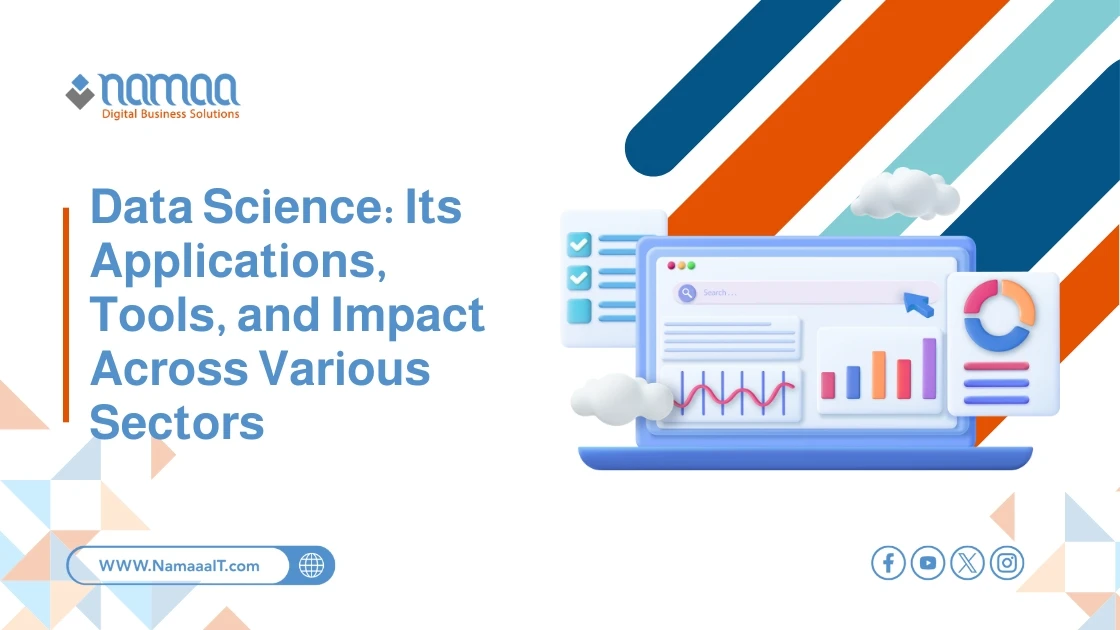What is Data Science?
Data Science is a multidisciplinary field that combines statistics, computer science, mathematics, and artificial intelligence to analyze data and extract valuable insights. Its goal is to transform raw data into useful information that supports decision-making and enhances performance across various sectors. Data Science techniques are used to process large volumes of structured and unstructured data, such as text, images, and videos, through multiple stages including data collection, cleaning, analysis, and building predictive models. Tools like Python and R, along with libraries such as TensorFlow and PyTorch, are used to develop these models.
Data Science applications span many areas, including healthcare (analyzing medical images and predicting diseases), e-commerce (enhancing user experience and recommending products), and finance (fraud detection and risk management).
What is Data Science (Rephrased)?
Data Science is a multidisciplinary field aimed at extracting knowledge and insights from data using scientific methods and techniques. It blends statistics, mathematics, programming, and sometimes artificial intelligence. In essence, it seeks to understand phenomena, analyze trends, and make future predictions by analyzing massive amounts of data. It involves gathering, cleaning, and analyzing data to derive valuable conclusions that support strategic decision-making in various industries such as healthcare, commerce, technology, and finance.
Data Science is not limited to extracting data only—it also includes analyzing available data to build predictive models that help organizations improve performance and make sound decisions. Tools and techniques like mathematical algorithms and machine learning models are used to build these systems. With the increasing size and complexity of data, Data Science has become a vital field in the modern digital world. It also integrates the analysis of both structured and unstructured data (e.g., text, images, videos), which enhances organizations’ ability to understand the environments they operate in.
History of Data Science
The history of Data Science has gone through several evolutionary phases. Initially, the focus was on statistics and analyzing live data using simple tools such as tables and probability distributions. Over time, more advanced tools and techniques emerged, such as data analysis using dedicated software like Excel in the 1970s and 1980s. These methods were mostly limited to basic calculations and did not leverage modern computing power or big data.
At the turn of the 21st century, with tremendous advancements in technology, Data Science began taking a more comprehensive form. It became possible to gather massive amounts of data (Big Data) from sources like the internet, social media, and smart devices. This transformation was driven by advancements in artificial intelligence (AI) and machine learning (ML), which radically changed how data is processed and insights are extracted. Modern technologies such as cloud computing have also made data more accessible and easier to analyze in real time.
Today, Data Science integrates traditional statistics with AI to extract knowledge from diverse and complex data. It plays a crucial role in impactful decision-making across most industries worldwide. Insights derived from data analysis are now a core part of growth strategies for companies and institutions.
read more: AI Applications in Operations Management
Tools and Technologies in Data Science
Data Science heavily relies on a wide range of tools and technologies that enable professionals to analyze data and draw conclusions. One of the essential tools is Python, the most widely used programming language in data analysis. Python is highly flexible and supports numerous specialized libraries for Data Science such as NumPy, Pandas, Matplotlib, and Scikit-Learn, which simplify working with complex datasets. Python is widely used for developing machine learning models and data visualization.
In addition to Python, R is another powerful tool for statistical data analysis, especially known for handling complex mathematical data and performing advanced statistical analyses. Hadoop is another technology used for big data management. It enables the storage and analysis of massive amounts of data across a network of connected computers. Hadoop relies on techniques like MapReduce for distributed processing, which allows analysis to be shared across multiple servers, increasing speed and efficiency.
Other tools like Spark and TensorFlow offer advanced solutions for data analysis and AI model development. While Hadoop is mainly used for distributed data processing, Spark allows real-time data processing, making it ideal for applications that require quick responses. These tools enable Data Science to meet modern digital demands and maximize the value of available data.
Difference Between Data Science and Data Analysis
Despite their similarities, there is a fundamental difference between Data Science and Data Analysis. Data Analysis is a subset of the broader Data Science process. It focuses primarily on examining data to draw conclusions based on direct observation of the available data. Data analysts use statistical methods to gain insights from historical or current data, often using pivot tables and distribution analysis.
On the other hand, Data Science covers a much broader scope. It involves collecting, cleaning, organizing, and analyzing data using more advanced techniques like machine learning and data mining. Data scientists don’t just analyze data—they also develop models and theories that help predict future outcomes based on detected patterns. Data Science deals with large, diverse data sets—structured and unstructured—and applies advanced tools and techniques for more complex and professional analysis.
Machine Learning and Its Relationship with Data Science
Machine Learning (ML) is a branch of artificial intelligence that focuses on developing algorithms and software that can learn from data and improve their performance over time without being explicitly programmed. ML uses historical data to identify patterns and relationships, enabling systems to make predictions or decisions based on previously unseen data. In the context of Data Science, machine learning is a key tool for analyzing big data and extracting valuable information.
In Data Science, ML is used to develop predictive models that aid in informed decision-making. These models include various techniques such as linear regression, random forests, and artificial neural networks. Machine learning enables the analysis of unstructured data like text, images, and videos, enhancing Data Science's ability to handle different data types. For instance, in healthcare, ML can analyze medical images to detect early signs of disease, while in business, it helps analyze customer data to predict market trends.
ML also contributes to continuous system performance improvement, as it learns and evolves over time—making models more accurate and effective. Thus, machine learning is one of the core components supporting Data Science’s ability to derive insights and deliver valuable outcomes across industries.
Artificial Intelligence (AI) and Its Role in Data Science
Artificial Intelligence (AI) is an innovative technology that aims to simulate human intelligence using computer systems. In the realm of Data Science, AI is a vital component in developing advanced analytical solutions that enhance the ability to process and analyze data and detect complex patterns. AI in Data Science relies on techniques like deep learning and artificial neural networks, enabling more efficient analysis of large and complex datasets than traditional methods.
AI applications in Data Science allow for faster and more accurate prediction and classification systems. For example, in image and video analysis, AI algorithms like deep neural networks can extract information from visuals that traditional techniques may struggle with. In healthcare, AI can analyze medical images faster and more accurately than human doctors, contributing to early diagnosis and improved treatments.
In the business world, AI enhances customer experience by analyzing online behavior and providing personalized recommendations. It also uncovers hidden patterns in data that may be invisible through traditional methods. By leveraging AI, companies can achieve significant improvements in operational efficiency and manage data more effectively. Therefore, AI plays a central role in boosting the outcomes of Data Science and enhancing its capacity to deliver innovative solutions.
Applications of Data Science in Healthcare
Data science plays a vital role in the healthcare sector by improving disease diagnosis, developing treatments, and enhancing the overall efficiency of medical services. Hospitals and health centers today use data science techniques to analyze massive amounts of medical data such as electronic health records (EHR) and medical imaging. These analyses contribute to improved diagnostic accuracy by identifying patterns in the data that can help detect diseases at early stages, such as cancer and heart conditions.
A prominent application of data science in healthcare is the use of machine learning to analyze radiology and nuclear medicine images. The algorithms used in this field can detect tumors or health issues in medical images that may be difficult to observe with the human eye. This technology offers patients faster and more accurate diagnoses, reducing medical errors and improving the chances of early treatment.
Additionally, data science is used to analyze genetic data and track hereditary factors that may affect individual health. This can help predict future health risks and develop personalized preventive strategies for each patient. Data science technologies also improve hospital management by automating scheduling processes and optimizing resource allocation, leading to increased efficiency and cost reduction.
How Data Science is Used in Business and Commerce
In the business world, data science is a powerful tool used for strategic decision-making and gaining a competitive edge. By analyzing vast amounts of customer data, companies can better understand customer behavior and offer customized products and services based on their preferences. Data science helps improve marketing strategies by predicting market trends and directing advertising campaigns more effectively.
In e-commerce, data science is used to analyze customer behavior online—such as browsing history and past purchases—to provide personalized recommendations and boost sales. For example, platforms like Amazon and Netflix use data science-based recommendation algorithms to enhance user experience and increase engagement. Data science is also used in pricing optimization by analyzing competition and market conditions, enabling businesses to adopt dynamic pricing strategies aligned with demand and supply.
Moreover, data science enhances logistics and supply chain optimization. By analyzing shipping and storage data, companies can improve transportation methods and reduce costs. In the manufacturing sector, data science improves productivity by continuously monitoring performance and detecting issues on production lines, which reduces unplanned downtime and increases efficiency. Data science is key to enabling data-driven business strategies and continuous performance improvements.
Data Science in the Financial Sector
Data science has become an essential part of the financial sector, where it’s used to analyze financial risks and detect suspicious patterns that may indicate fraud. Big data analysis and machine learning models allow banks and financial institutions to anticipate risks and identify potential threats more accurately and swiftly. For example, data science-powered systems can analyze historical transaction patterns and predict unusual activities that might indicate fraudulent behavior, such as identity theft or illegal transactions.
A key tool in this context is machine learning algorithms such as Random Forest and Neural Networks, which are used to build classification models capable of identifying suspicious transactions and issuing instant alerts. Furthermore, data science can analyze complex financial data like stock and bond prices to assess risks and provide suitable investment strategies. These tools allow banks and investors to monitor markets and make better financial decisions based on accurate data.
Additionally, data science is used in internal risk management processes. For instance, data science-supported systems can forecast unexpected events like financial crises or economic changes, helping financial institutions plan effective risk mitigation strategies. These analyses contribute to minimizing potential losses and ensuring the sustainability of financial companies.
The Impact of Data Science on Education and Learning
Data science has a growing impact on the education sector by enhancing and personalizing the learning experience based on individual student needs. Using machine learning and data analysis techniques, educational systems can track student performance in real time and provide precise feedback on areas for improvement. For example, test results and academic activities can be analyzed to identify students' strengths and weaknesses, allowing teachers to tailor teaching strategies to each student’s needs.
Data science also improves educational programs by identifying patterns in student performance and developing educational content accordingly. For example, data might reveal that students struggle with a specific topic, enabling schools to adjust the curriculum to better meet their needs. Additionally, machine learning-based systems can offer interactive assessments that help students improve their skills in a personalized way.
Using machine learning tools, educational platforms can be designed to adapt to each student’s learning style, boosting self-paced learning. Data science also facilitates delivering education in virtual environments supported by technologies like artificial intelligence, where interactive educational materials match the student’s learning capacity.
Big Data and Its Relationship with Data Science
Big Data refers to enormous amounts of data that are generated rapidly and require advanced technologies for processing and analysis. In this context, data science is the primary tool that allows us to extract value from this massive data. Big Data includes a wide range of sources such as social media, smart IoT devices, electronic transaction records, and biometric data, which significantly increases the volume of data that needs to be analyzed.
Data science enables organizations to process this massive data and extract insights that support strategic decision-making. For example, in healthcare, data science techniques can analyze patient data from various sources—like medical records and health monitoring devices—to provide more accurate diagnoses and personalized treatments. In e-commerce, Big Data can be used to analyze customer behavior and provide personalized recommendations to improve the overall user experience.
Efficient Big Data processing requires tools and technologies like Hadoop and Spark, which allow for distributed data processing across multiple servers. These tools enable companies to handle large and diverse data in real-time. Data science also contributes to transforming raw data into valuable information using various techniques like machine learning and text analysis, allowing organizations to get the most out of Big Data.
Data Science in Marketing
In marketing, data science has become a critical tool for boosting efficiency and achieving higher returns on investment (ROI). Through data analysis, marketers can better understand customer behavior and develop targeted marketing strategies tailored to individual preferences. For instance, with data science techniques, data can be collected and analyzed from websites, social media, and apps to deliver personalized customer experiences and increase brand engagement.
One of the applications in this field is analyzing customer behavioral data, such as browsing and purchase history. This data can reveal patterns that help deliver products or services tailored to each customer. For example, companies like Amazon and Netflix use data science-powered recommendation algorithms to suggest content based on past user behavior. This enhances customer experience and increases repeat purchases.
Data science can also optimize online advertising campaigns by analyzing ad responses and testing the most effective marketing messages. With predictive analytics, marketers can identify future customer behavior trends and adapt their strategies accordingly. Data science can also help pinpoint target audiences more accurately, reducing advertising costs and increasing campaign returns.
Summary:
✅ Data Science in Finance: 70% of financial institutions use data science techniques to analyze financial risks and detect fraud.
✅ Fraud Detection with Data Science: 60% of online financial transactions are analyzed using data science algorithms to identify suspicious patterns.
✅ Financial Data Analysis: 50% of financial institutions rely on data-based predictive models to improve investment strategies.
✅ Impact of Data Science in Education: 80% of schools rely on data analysis to personalize the learning experience and improve student performance.
✅ Machine Learning in Education: 75% of online learning platforms use machine learning to analyze student performance and customize curricula.
✅ Big Data: Around 2.5 quadrillion bytes of data are generated daily worldwide, and data science is used to analyze this massive volume.
✅ Big Data Processing Tools: 85% of companies use tools like Hadoop and Spark to process and analyze Big Data in real-time.
 Home
Let's think together
Articles
About
Contact Us
عربي
عربي
Home
Let's think together
Articles
About
Contact Us
عربي
عربي



.webp)


.webp)
 A Complete Guide to Increasing User Reach (2).webp)
